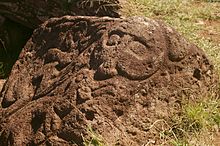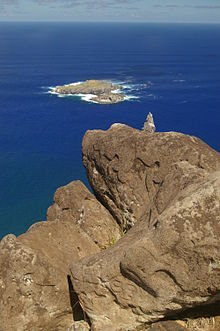Makemake (mythology)
Makemake (also make-make ; pronounced [ˈmakeˈmake]) is the creator and fertility goddess of the culture of Easter Island . In the Vogelmannkult ( Tangata manu ) Makemake is the main deity. Makemake almost always appears together with his companion Haua in the stories of the Rapanui . Both Makemake and Haua appear only in the Easter Island religion, not in other Polynesian religions.
Legend
The Rapanui creation myth tells the following story:
- After Makemake created the earth, he felt that something was missing. That day he recognized his reflection in a water-filled calabash. As a bird landed on his shoulder at that moment, he saw his face with wings and beak. He breathed life into the image and it became his firstborn. Then Makemake wanted to create a being that could talk like him and he breathed life into the water, so that the fish came into being. But the result was not what I wanted and so he breathed life into a stone on land and so the first human was created. When Makemake saw that the man was lonely, he created the woman. Makemake gave them Rapanui as their land.
A myth of the Rapanui tells of the beginning of the Makemake cult:
- A sacred skull that was guarded by a priestess once lay on one of the ahu platforms. When this fell into the sea in a storm, the priestess dived afterwards to save the skull, which she succeeded. Exhausted, she was resting on a neighboring island when her Haua appeared and revealed to her that the skull she had rescued belonged to none other than the great god Makemake. Haua told her to return and teach her people how to pray to him and Makemake and make offerings to them.
- In the meantime, Makemake and Haua decided to drive the seabirds away from Rapanui because the inhabitants ate their eggs. The birds then settled on the offshore, uninhabited island of Moto Nui . To commemorate this event, residents held a ceremony every year in which young men competed in swimming to the island and returning with the first egg.
cult
Makemake is often depicted on petroglyphs in the islands as a mask-like face with large, owl-like eyes.
From around 1500 to 1867 there was an annual ceremony based on the Makemake cult and used to determine the head of the island. Each tribe sent a warrior who had to swim to the offshore island of Motu Nui to bring back the first bird's egg of the year. The chief of the tribe, whose warrior brought the egg, was appointed a "bird man" ( tangata-manu ) for one year , who in addition to the function of head also had an intermediary function between the inhabitants and the god Makemake.
reception
The trans - Neptunian dwarf planet Makemake , originally called 2005 FY9 , got its name as an allusion to the discovery date at Easter on Easter Island.
swell
- Alfred Metraux: Ethnology of Easter Island. , [1940] 1971, Bernice P. Bishop Museum Bulletin 160, Honolulu, Bishop Museum Press
- Katherine Routledge : The Mystery of Easter Island , 1919 ISBN 0-932813-48-8
- Jo Annevan Tilburg: Easter Island: Archeology, Ecology and Culture. , 1994, Washington DC, Smithsonian Institution Press
Individual evidence
- ^ A b Robert D. Craig: Handbook of Polynesian Mythology , ABC-CLIO, 2004, p. 63 online version
- ^ A b Robert D. Craig: Handbook of Polynesian Mythology , ABC-CLIO, 2004, p. 162 online version
- ↑ (136472) 2005 FY9 Named Makemake ( memento of the original from December 19, 2013 in the Internet Archive ) Info: The archive link was inserted automatically and has not yet been checked. Please check the original and archive link according to the instructions and then remove this notice.
- ↑ Mike Brown: Mike Brown's Planets: What's in a name? (part 2) . In: CalTech . 2008. Retrieved July 14, 2008.

